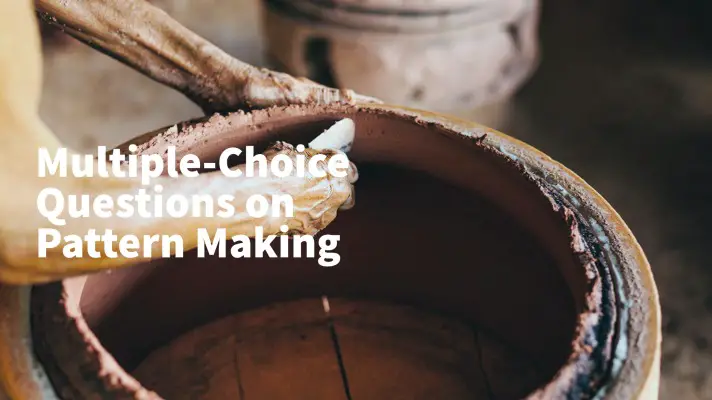In all the examinations, there must be multiple-choice questions. In this article, I will display some Multiple-Choice Questions on Pattern Making that will boost you in examinations and also in viva.
In the last section, there will be a Quiz of 10 marks on Pattern Making. Appear for the test and fall in love with studying a lot of objective-type questions.
To download this MCQ sheet, you have to reach the end of this page. There you will find a PDF downloadable button. Click and download the PDF version of this sheet.
So now let’s start the objective-type questions or viva questions.

MCQ questions or Viva Questions on Pattern Making
- Sometimes the patterns are given a slight taper on its vertical surfaces. This is given for keeping:
- Shrinkage allowance
- Machining allowance
- Draft allowance
- Shake allowance
Ans: (3)
- Risers that act as an reservoir actually helps in taking care of:
- Shrinkage allowance
- Machining allowance
- Draft allowance
- Shake allowance
Ans: (1)
- Machining allowance is required in Casting because:
- Material may contract.
- For finishing operation after casting, we may loose dimensional parameters.
- Of removing the patterns easily.
- None of these
Ans: (2)
- In sand casting, patterns are made of:
- Wood
- Plastic
- Metal
- All of these
Ans: (4)
- Which of the following wood is best suitable for making patterns?
- Mahogani
- Teak
- Maple
- White pine
Ans: (4)
- Which of the following pattern you can handle roughly?
- Cast iron
- Brass
- Aluminium
- None of these
Ans: (3)
- In which of the following pattern, multi-cavity moulds may be prepared during casting?
- Solid pattern
- Gates pattern
- Match plate pattern
- None of these
Ans: (2)
- For symmetrical castings of a circular cross section, which pattern will you use?
- Skeleton pattern
- Gates pattern
- Sweep pattern
- Single-piece pattern
Ans:(3)
- How many minimum numbers of runners can be used in case of multi-cavity molds?
- 4
- 3
- 2
- 1
Ans: (4)
- Which of the following expands on solidification?
- Plaster of paris
- Metals
- Plastics
- Wax
Ans:(1)
- Which color is used to indicate the machined surfaces of casting?
- Red
- Green
- Black
- Blue
Ans:(1)
- Phenolic resins are actually ____.
- Plaster of paris
- Metals
- Plastics
- Wax
Ans: (3)
- For supporting the cores in the casting, you need-
- Binders
- Chaplets
- Clay
- None of these
Ans: (2)
- In Investment casting, the material of the pattern is:
- Synthetic sand
- Phenolic resin
- Wax
- Plastics
Ans: (3)
- Which of the following forms the seat for a core?
- Core print
- Mold print
- Both (1) and (2)
- Draft
Ans: (1)
- Patterns are always made____ the actual size of the casting.
- Equal to
- Smaller than
- Larger than
- Either equal or smaller than
Ans: (3)
- In which allowance, the external dimensions are increased and internal dimensions are decreased?
- Machining allowance
- Draft allowance
- Shake allowance
- Shrinkage allowance
Ans: (4)
- Plastics that are used in making the patterns is called
- Phenolic resin
- Thermosetting resin
- Both (1) and (2)
- None of these
Ans: (3)
- From which of the following material, you can’t make pattern?
- Plastic
- Wax
- Wood
- Oil
Ans: (4)
- Pattern is the
- Cavity within which hot molten metal is poured.
- Replica of the part to be cast
- Vertical passage
- Horizontal passage that connects the mold with the runner.
Ans: (2)
- Which of the following criteria you need not look after while selecting the pattern materials?
- Method of molding
- Complexity in the casting
- Establishment of parting line
- None of these
Ans: (3)
- Which of the following pattern has a longer life?
- Wooden pattern
- Metallic pattern
- Wax pattern
- None of these
Ans: (2)
- For how long time you should keep the resin mixture for hardening and curing in solid casting method?
- 4-5 hours
- 3-4 hours
- 2-3 hours
- 1-2 hours
Ans: (3)
- By which pattern, core boxes are made?
- Wax pattern
- Metal pattern
- Plastic pattern
- Plaster pattern
Ans: (4)
- Which pattern possesses high compressive strength?
- Plaster pattern
- Wooden pattern
- Wax pattern
- None of these
Ans: (1)
- Which of the following properties the core sand has?
- Permeability
- Refractoriness
- Smoothy surface
- All of the above
Ans: (4)
- Which pattern will provide you a cheapest operation?
- Match plate pattern
- Gated pattern
- Skeleton pattern
- Sweep pattern
Ans: (3)
- A chaplet is
- A projection on a pattern that leaves an impression in the mold
- A small metal insert used in molds to provide core support
- A metal insert in the sand mold used to produce local chilling
- None of these
Ans:(2)
- A chill is
- A projection on a pattern that leaves an impression in the mold
- A small metal insert used in molds to provide core support
- A metal insert in the sand mold used to produce local chilling
- None of these
Ans: (3)
- Which of the following defects can be caused by the low permeability in sand?
- Drop
- Hot tears
- Blow holes
- None of these
Ans: (3)
Quiz on Pattern
Here is the quiz for you:
Overview
A pattern is the replica of the object to be procured by Casting. Casting is a manufacturing process by which you can create the products with the help of hot liquid molten material.
The entire casting process includes: pattern or core making, moulding, melting of the material, fettling and finishing.
There are different types of patterns: solid or single piece pattern, split or two-piece pattern, multipiece pattern, match plate pattern, gated pattern, skeleton pattern, sweep pattern, pattern with loose pieces,cope and drag pattern,follow board pattern.
Conclusion
I hope that the Multiple-Choice Questions on Pattern Making will help you in your college/university examinations and different types of competitive examinations. I will be more encouraged if I get feedback from your end. Please don’t forget to give the feedback by writing in the comment box. Good Luck!


